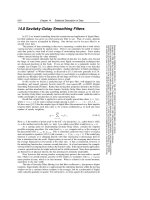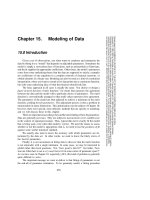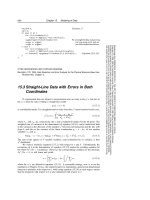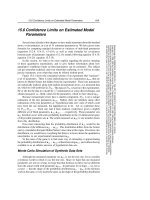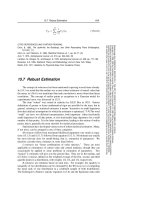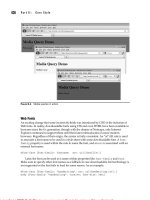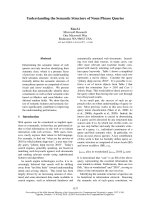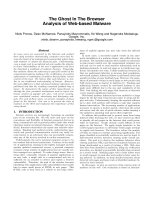THE FRACTAL STRUCTURE OF DATA REFERENCE- P14 ppt
Bạn đang xem bản rút gọn của tài liệu. Xem và tải ngay bản đầy đủ của tài liệu tại đây (58.29 KB, 5 trang )
Chapter 4
USE OF MEMORY AT THE I/O INTERFACE
In the traditional view of the memory hierarchy, the I/O interface forms a key
boundary between levels. In this view, the level above the
I/O interface consists
of high speed processor memory; the level below consists of disk storage,
which can store far more data, but requires physical movement, including disk
rotation and head positioning, as part of data access.
The presence of storage control cache in modern storage controls has made
for complications in the simple picture just described. Essentially similar
semiconductor memory technologies now exist on both sides of the
I/O interface.
Since the the early 1980’s, increasingly large file buffer areas, and increasingly
large cache memories, have become available. This raises the question of
how best to manage the deployment of semiconductor memory, some for file
buffer areas and some for storage control cache, so as to maximize the gains in
application performance.
The theme of this chapter is that, for most application data, it is possible to
accomplish performance gains through a division of labor, in which each of the
two memory technologies plays a specific role:
File buffer areas, in the processor, are used to hold individual data records
for long periods of time.
Storage control cache contributes additional hits by staging the entire track
of data following a requested record, and holding it for shorter times.
In addition, storage control cache provides the capability to cache writes,
which usually cannot be hardened in the processor buffers.
In broad terms, the objective of this strategy is to minimize the number
of requests that must be serviced via physical disk access. Equivalently, the
objective is to minimize the number of storage control cache misses. It is
52
important to observe that this is not the same as wishing to maximize the
number of storage control cache hits. Instead, we choose to service many
or most application requests in the processor, without ever allowing them to
appear as
I/O operations. For this reason, the strategy just proposed may conflict
with, and override, the frequently adopted objective of achieving high storage
control hit ratios, measured as a percentage of
I/O.
The initial two sections of the present chapter comprise a case study, in
which we simulate the deployment of memory to support a range of specific
files identified in one
OS/390 trace. The final section uses the hierarchical reuse
model to examine, in greater detail, the division of labor just proposed in the
previous paragraph. We show that a balanced deployment of semiconductor
memory, using both memory technologies, is likely to be the most cost
-
effective
strategy for achieving high performance.
THE FRACTAL STRUCTURE OF DATA REFERENCE
1. SIMULATION USING TIME
-
IN
-
CACHE
To allow a detailed study of memory deployment, taking into account both
processor memory and storage control cache, a simulation of both of these
memory technologies and their interaction was developed. Some of the ideas
previously introduced in Chapter 1, particularly the central concept of single
-
reference residency time, were applied to simplify the needed simulation soft
-
ware.
Misses in each type of memory were determined by applying the criterion
of time
-
in
-
cache. So as to accomplish a division of labor between processor
file buffers and storage control cache, a much longer single
-
reference residency
time objective was adopted for the former than for the latter (600 seconds versus
60 seconds), Those I/O’s identified as file buffer misses were placed into a side
file, and became the input for a subsequent simulation of storage control cache.
An additional storage control cache simulation was also performed based upon
the original trace, so as to allow for the possibility that file buffering might not
be present.
In all simulations, the cache memory requirements were calculated by ac
-
cumulating, for each hit, the time since the requested data had been at the top
of the
LRU list. The average of such accumulated times yields a practical mea
-
surement of g(τ), whose theoretical definition is stated in (1.8). Based upon
g(τ), the average residency time was computed by applying (1.9) and (1.7).
Finally, the corresponding memory use was obtained from (1.18).
Note that this procedure is not subject to the sources of error examined
in the previous chapter. If it is applied on a file
-
by
-
file basis, the procedure
just described yields each file’s individual cache residency time and memory
requirements.
Moreover, it is possible to perform the analysis of any one file, independently
of all other files. This fact was extremely helpful during the case study, since it
Use of Memory at the I/O Interface
53
meant that all memory deployment strategies of interest could be tested against
all of the files. The most suitable deployment strategy for each file could then
be selected afterward, based upon the simulation results.
2. A CASE STUDY
We are now ready to apply the simulation, just discussed above, to a specific
case study. The installation examined in the case study was a large
OS/390
environment running primarily on
-
line database applications.
More specifi
-
cally, most applications were constructed using the Customer Information and
Control System (
CICS) to facilitate terminal interactions and manage database
files. Databases constructed using DataBase 2 (
DB2) and Information Man
-
agement System (IMS) database management software were also in heavy use.
Most database storage was contained in Virtual Storage Access Method (
VSAM)
files.
Our examination of the installation of the case study is based on a trace of all
storage subsystem
I/O during 30 minutes of the morning peak. The busiest 20
files (alsocalleddatasets)appearing inthis trace are presented in Table 4.1. For
each file, the table shows the processor and cache memory requirements needed
to deliver single
-
reference residency times of 600 and 60 seconds, respectively.
Also shown are the percentages of traced
I/O requests that would be served out
of processor or cache memory, given these memory sizes.
Note that the use of events traced at the
I/O interface, as a base for the
analysis presented in Table 4.1, represents a compromise.
Conceptually, a
more appealing alternative would be to base the analysis on a trace of the
logical data requests made by the application, including those requests served
in the processor without having to ask for data from disk. A key aim of the case
study, however, was to capture a global picture of all disk activity, including
all potential users of processor buffering or storage control cache. A global
picture of this kind was believed to be practical only relative to events captured
at the
I/O interface.
Inasmuch as events at the
I/O interface are the base for reporting, application
requests that are hits in the existing processor buffers do not show up in the
I/O
trace and are not reflected in the projected percentages of I/O served by the pro
-
cessor. Only the additional I/O’s that may be intercepted by adding more buffer
storage are shown. The calculation of buffer memory requirements, as just
described in the previous section, does, however, subsume the existing buffer
storage (the simulated buffer storage must exceed the existing buffer storage
before the simulation reports
I/O’s being handled as hits in the processor).
With the dynamic cache management facility of
OS/390, it is possible to place
“hints” into the
I/O requests that access a given, selected file, recommending
against the use of cache memory to store the corresponding data. Many con
-
trollers respond to such hints, either by not placing the data into cache memory,
Data Set Memory Processor I/O Projected Projected Percent of
Types Used Buffering Rate Memory (MB) Trace I/O
CU? PR? Technique Cache Buffers Disk Served by
Write Cache Buffers
IMS VSAM database Y Y Hiperspace 58.0 2.8 8.7 0.9 2.6 96.1
CICS VSAM database Y Y Hiperspace 26.6 1.0 13.2 0 3.2 95.4
DB2 index Y Y Hiperpool 25.0 0.0 2.4 0.9 1.2 98.7
IMS VSAM database Y Y Hiperspace 18.1 6.5 14.9 7.5 17.1 65.8
shared multi
-
db flat file Y N n/a 16.2 23.4 0 2.1 33.2 0
JES2 checkpoint Y N
n/a 14.9
0.6 0 80.0
99.7 0
job scheduler flat file
Y N
n/a 14.6 0.1 0
25.2 100 0
JES2 spool storage Y N
n/a
13.6
3.3 0 66.9
91.6 0
JES2 spool storage Y N
n/a
13.3 3.3 0
68.5
91.8 0
SMF MAN1 flat file Y N
n/a
13.2
1.8 0 63.6
97.7 0
DB2 tablespace Y Y
Hiperpool
13.1
1.8 35.5 0.3
7.0
86.5
VVDS (catalog volume) Y N
n/a
12.8
0.0 0 0.1
100
0
JES2 spool storage Y N
n/a
12.7 3.3 0
69.3
91.1 0
JES2 spool storage Y N
n/a
11.7
3.1 0 68.1
90.9 0
CICS VSAM index Y Y
Hiperspace
11.5
0.0 0.0 0 0.0
99.9
CICS journal Y N
n/a
10.6 0.1 0 100
100 0
application work area Y N
n/a
10.2 0.6 0 100
98.9 0
ClCS load library Y Y prog lib 13.6 1.0 21.5 1.1 2.8 93.1
DB2 tablespace Y Y
Hiperpool
11.5
2.9 27.0
0.4 13.1 75.0
DB2 tablespace
Y Y Hiperpool
10.7
1.2 14.1
0.3 8.9 86.6
Summaries for: Hiperspace 730.9 377.7 467.7 16.3 43.0 38.0
Hiperpool 192.0 46.2 327.8 10.2 22.1 66.4
prog lib 89.2 10.6 61.8 3.6 25.8 69.4
n/a 433.6 221.1 0 38.3 86.2 0
54 THE FRACTAL STRUCTURE OF DATA REFERENCE
Table 4.1. Busiest 20 files (data sets) in the case study.
Use of Memory at the I/O Interface 55
or else by subjecting it to early demotion (this can be done by placing the data
at or near the bottom of the
LRU list when it is staged). Similarly, the system ad
-
ministrator can choose which databases should be supported by a given buffer
pool. To take maximum advantage of this flexibility, the simulation results were
placed into a spreadsheet, so that the option could be exercised, for each of the
busiest installation files, whether or not to deploy that file’s projected processor
and storage control cache memory requirements. This choice is indicated by
the two yes
-
or
-
no columns presented in Table 4.1.
Table 4.1 also indicates the method (if any) by which special, large buffer
areas can be defined for use by a given file or group of files. More specifically,
the figure refers to the following methods:
Hiperspace: Special extensions of the VSAM Local Shared Resource buffer
area.
Hiperpool: Special
DB2 buffer pool extensions.
Prog lib: special storage for frequently used programs, provided through
the Virtual Lookaside Facility/Library Lookaside (
VLF/LLA).
The figure does not contain examples of the full range of facilities available for
using large processor buffer areas in
OS/390.
Some files, such as the
CICS journal data set presented in Table 4.1, cannot
make effective use of large processor buffer areas. For such files, Table 4.1
shows the deployment of storage control cache memory, but not the deployment
of processor memory.
By contrast, a few small files exist (for example, certain program libraries)
for which it is possible to obtain 100 percent hit ratios in the processor by
setting aside enough buffer storage to contain them entirely. This can be done,
however, for at most a very small fraction of all files, due to the immense ratio
of disk relative to processor storage in a typical installation.
Since Table 4.1 shows the busiest 20 files observed during the case study,
it should not be surprising that files required to perform system services (e.g.
spool storage) play a prominent role. The table also, however, shows a number
of examples of ordinary database files. It shows that such files, which typi
-
cally represent the largest portion of installation storage, can make consistent,
effective use of both processor storage and storage control cache.
For database files, the recommended amount of storage control cache, as
shown in the table, is usually smaller than the amount of processor mem
-
ory. This reflects the specialized role in which storage control cache has been
deployed. Since storage control cache is used primarily to capture write oper
-
ations, plus any read hits that come from staging an entire track of data rather
than a single record, we project only a moderate amount of such cache as being
necessary.
